Related Research Articles

The Lumière brothers, Auguste Marie Louis Nicolas Lumière and Louis Jean Lumière, were French manufacturers of photography equipment, best known for their Cinématographe motion picture system and the short films they produced between 1895 and 1905, which places them among the earliest filmmakers.

A zoetrope is a pre-film animation device that produces the illusion of motion, by displaying a sequence of drawings or photographs showing progressive phases of that motion. A zoetrope is a cylindrical variant of the phénakisticope, an apparatus suggested after the stroboscopic discs were introduced in 1833. The definitive version of the zoetrope, with replaceable film picture film strips, was introduced as a toy by Milton Bradley in 1866 and became very successful.
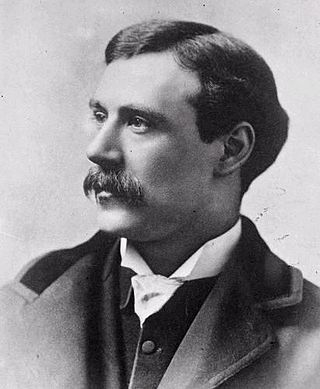
William Friese-Greene was a prolific English inventor and professional photographer. He was known as a pioneer in the field of motion pictures, having devised a series of cameras between 1888–1891 and shot moving pictures with them in London. He went on to patent an early two-colour filming process in 1905. Wealth came with inventions in printing, including phototypesetting and a method of printing without ink, and from a chain of photographic studios. However, Friese-Greene spent all his money on inventing, went bankrupt three times, was jailed once, and died in poverty.
3D films are motion pictures made to give an illusion of three-dimensional solidity, usually with the help of special glasses worn by viewers. They have existed in some form since 1915, but had been largely relegated to a niche in the motion picture industry because of the costly hardware and processes required to produce and display a 3D film, and the lack of a standardized format for all segments of the entertainment business. Nonetheless, 3D films were prominently featured in the 1950s in American cinema, and later experienced a worldwide resurgence in the 1980s and 1990s driven by IMAX high-end theaters and Disney-themed venues. 3D films became increasingly successful throughout the 2000s, peaking with the success of 3D presentations of Avatar in December 2009, after which 3D films again decreased in popularity. Certain directors have also taken more experimental approaches to 3D filmmaking, most notably celebrated auteur Jean-Luc Godard in his film Goodbye to Language.
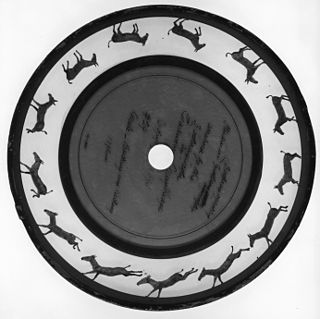
The zoopraxiscope is an early device for displaying moving images and is considered an important predecessor of the movie projector. It was conceived by photographic pioneer Eadweard Muybridge in 1879. Muybridge used the projector in his public lectures from 1880 to 1895. The projector used 16" glass disks onto which Muybridge had an unidentified artist paint the sequences as silhouettes. This technique eliminated the backgrounds and enabled the creation of fanciful combinations and additional imaginary elements. Only one disk used photographic images, of a horse skeleton posed in different positions. A later series of 12″ discs, made in 1892–1894, used outlines drawn by Erwin F. Faber that were printed onto the discs photographically, then colored by hand. These colored discs were probably never used in Muybridge's lectures. All images of the known 71 disks, including those of the photographic disk, were rendered in elongated form to compensate the distortion of the projection. The projector was related to other projecting phenakistiscopes and used some slotted metal shutter discs that were interchangeable for different picture disks or different effects on the screen. The machine was hand-cranked.
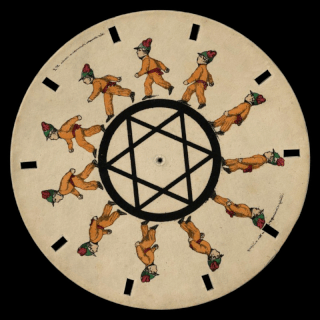
The phenakistiscope was the first widespread animation device that created a fluid illusion of motion. Dubbed Fantascope and Stroboscopische Scheiben by its inventors, it has been known under many other names until the French product name Phénakisticope became common. The phenakistiscope is regarded as one of the first forms of moving media entertainment that paved the way for the future motion picture and film industry. Similar to a GIF animation, it can only show a short continuous loop.
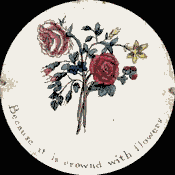
A thaumatrope is an optical toy that was popular in the 19th century. A disk with a picture on each side is attached to two pieces of string. When the strings are twirled quickly between the fingers the two pictures appear to blend into one. The toy has traditionally been thought to demonstrate the principle of persistence of vision, a disputed explanation for the cause of illusory motion in stroboscopic animation and film.

Precursors of film are concepts and devices that have much in common with the later art and techniques of cinema.
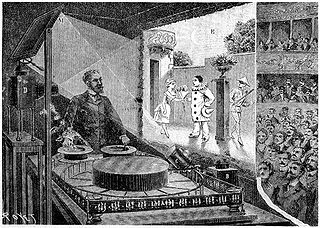
The Théâtre Optique is an animated moving picture system invented by Émile Reynaud and patented in 1888. From 28 October 1892 to March 1900 Reynaud gave over 12,800 shows to a total of over 500,000 visitors at the Musée Grévin in Paris. His Pantomimes Lumineuses series of animated films include Pauvre Pierrot and Autour d'une cabine. Reynaud's Théâtre Optique predated Auguste and Louis Lumière's first commercial, public screening of the cinematograph on 28 December 1895, which has long been seen as the birth of film.

Leonard Lipton was an American author, filmmaker, lyricist, and inventor. At age 19, Lipton wrote the poem that became the basis for the lyrics to the song "Puff, the Magic Dragon". He wrote books on independent filmmaking and was a pioneer in the field of projected three-dimensional imagery. Leonard Lipton developed 3D cinema technology that is used in RealD 3D cinemas. His technology is used to show 3D films on more than 30,000 theater screens worldwide.
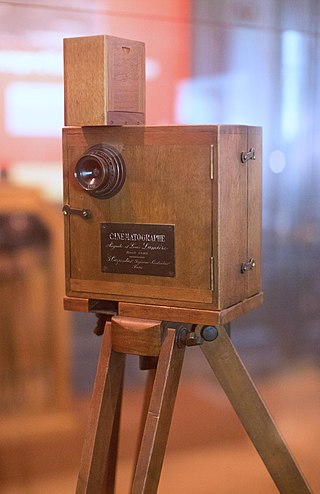
The history of film technology traces the development of techniques for the recording, construction and presentation of motion pictures. When the film medium came about in the 19th century, there already was a centuries old tradition of screening moving images through shadow play and the magic lantern that were very popular with audiences in many parts of the world. Especially the magic lantern influenced much of the projection technology, exhibition practices and cultural implementation of film. Between 1825 and 1840, the relevant technologies of stroboscopic animation, photography and stereoscopy were introduced. For much of the rest of the century, many engineers and inventors tried to combine all these new technologies and the much older technique of projection to create a complete illusion or a complete documentation of reality. Colour photography was usually included in these ambitions and the introduction of the phonograph in 1877 seemed to promise the addition of synchronized sound recordings. Between 1887 and 1894, the first successful short cinematographic presentations were established. The biggest popular breakthrough of the technology came in 1895 with the first projected movies that lasted longer than 10 seconds. During the first years after this breakthrough, most motion pictures lasted about 50 seconds, lacked synchronized sound and natural colour, and were mainly exhibited as novelty attractions. In the first decades of the 20th century, movies grew much longer and the medium quickly developed into one of the most important tools of communication and entertainment. The breakthrough of synchronized sound occurred at the end of the 1920s and that of full color motion picture film in the 1930s. By the start of the 21st century, physical film stock was being replaced with digital film technologies at both ends of the production chain by digital image sensors and projectors.

Barrier-grid animation or picket-fence animation is an animation effect created by moving a striped transparent overlay across an interlaced image. The barrier-grid technique originated in the late 1890s, overlapping with the development of parallax stereography (Relièphographie) for 3D autostereograms. The technique has also been used for color-changing pictures, but to a much lesser extent.
Events in 1876 in animation.
Events in 1870 in animation.
Events in 1869 in animation.
Events in 1864 in animation.
Events in 1862 in animation.
Events in 1860 in animation.
References
- ↑ Zone, Ray (2014-02-03). Stereoscopic Cinema and the Origins of 3-D Film, 1838-1952. University Press of Kentucky. ISBN 978-0-8131-4589-1.
- ↑ Herbert, Stephen (1998). Industry, Liberty, and a Vision: Wordsworth Donisthorpe's Kinesigraph. The Projection Box. ISBN 978-0-9523941-3-6.
- ↑ Mannoni, Laurent The Great Art of Light and Shadow (2000 translation by Crangle)
- ↑ "US31357.pdf" (PDF). docs.google.com. Retrieved June 14, 2021.
- ↑ Homer Croy (1918). How Motion Pictures are Made. Harvard University. Harper.
- ↑ Uebersicht der Arbeiten und Veränderungen im Jahre 1841 [Overview of works and changes in the year 1841] (in German). Breslau. 1842. pp. 62–63.
- ↑ "Phenakistiscope (disque de) AP-94-374" [Phenakistiscope (disk) AP-94-374] (in French). La Cinémathèque Française. Retrieved 20 July 2016.
- ↑ todayinsci.com Goodale patent docs
- ↑ S. Stevenson, A. Morrison-Low, A. Simpson, J. Lawson, R. Mackenzie, R. Gillanders and J. Lawson, Light from the Dark Room: A Celebration of Scottish Photography (Edinburgh: National Galleries of Scotland, 1995), ISBN 0903598582, pp. 20–1.
- ↑ Gress, Jon (2015). Visual Effects and Compositing. San Francisco: New Riders. p. 23. ISBN 9780133807240 . Retrieved 21 February 2017.
- ↑ Carroll 1996 , p. 146
- ↑ Kirby, Lynne (1997), Parallel Tracks: The Railroad and Silent Cinema, Durham: Duke University Press, ISBN 0822318393
- ↑ Rosen 1987, p. 747.
- ↑ Rosen 1987, p. 750.
- ↑ "Les vues cinématographiques | La Cinémathèque québécoise" (in French). Retrieved 2019-11-05.
- ↑ Gallimard (1928–1929). La Revue du cinéma (1928 - 1929). New York The Museum of Modern Art Library. Paris, Gallimard.
- ↑ Brownie, Barbara (2014-12-18). Transforming Type: New Directions in Kinetic Typography. Bloomsbury Publishing. ISBN 978-0-85785-533-6.
- ↑ "French Movie Pioneer Dies". Star Tribune. Minneapolis, MN. 23 January 1938. p. 9. Retrieved 6 November 2020– via Newspapers.com.

- ↑ "Georges Melies. French Motion Picture Producer a Pioneer in Industry". The New York Times. 23 January 1938. Retrieved 9 May 2008.
- ↑ Babbage, Charles (1864). Passages from the Life of a Philosopher. Longman, Green, Longman, Roberts, & Green. pp. 189.